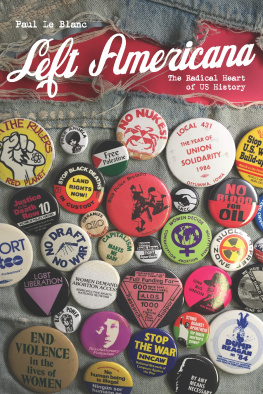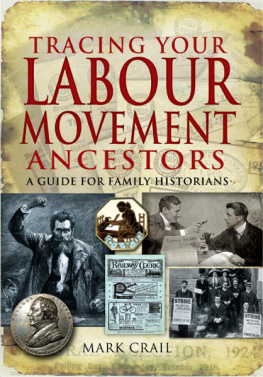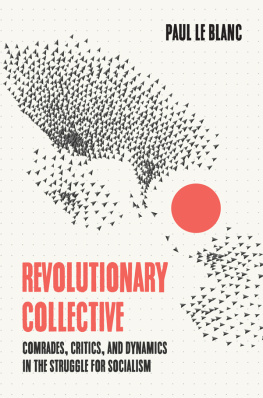Preface
Engaging with History
T his collection of essays, developed over roughly three decades, focuses on aspects of the history of the United States. This history has shaped me, but in some respects the inverse is true: because some of this history has unfolded in my lifetime, I have been able to make my own modest contribution in helping to shape it.
And, of course, the history continues to flow on as I write these words, and as you read them. The very interplay of the writing and the readingand of our shared thought processesare an element of the history of our times.
This way of thinkingthat we common people are part of history, that we all help to make historyis essential to the very meaning of the Left, which is the topic of the book whose initial paragraphs you have chosen to read. And if you, like me, find yourself in the United States of America, then you are one of a fairly significant number who have engaged in some way (simply by reading this far) with this kind of thinking. Which means that you have become part of the subject matter referred to in this books title Left Americana .
But we owe it to ourselves, perhaps, to consider a little more seriously the books title and the subject matter with which the book deals.
What Is the Meaning of This Books Title?
The term Americana is simple enough, so lets get that out of the way first.
My good friend Wikipedia has said: Americana refers to artifacts, or a collection of artifacts, related to the history, geography, folklore and cultural heritage of the United States. Merriam-Webster's Collegiate Dictionary defines Americana as materials concerning or characteristic of America, its civilization, or its culture; broadly : things typical of America. Here the word America is synonymous with United States of America. Objections could be made to such an expansive synonym (what about Canada? what about Mexico? what about the rest of the Americas?), but for now, well just go with the very common connotation of the term Americana.
That immediately raises the questionwhen we refer to Left Americanawhether anything left-wing is really characteristic or typical of the United States. Some of todays spokespeople for US conservatism will indignantly deny that this is possible: to be left-wing is to be quintessentially un-American . My belief, documented by various essays in this volume, is that the Left is as American as apple pie. Actually, the author of the original Pledge of Allegiance to the US flag and the man historically credited with inventing the quintessential American game of baseball were left-wing. Christian socialist and Baptist minister Francis Bellamy (younger brother of socialist novelist Edward Bellamy) composed the original Pledge in the 1890s. Civil War hero Abner Doubleday (who it turns out didnt actually invent the game, but apparently did have his Union Army troops play it between battles) was an early member of a network of clubs inspired by the older Bellamys Looking Backward . In fact, American left-wingers played a defining role both in shaping the international Left and in making this country what it is todayand what it can become tomorrow. At the heart of the Left are principles of government of the people, by the people, and for the people, the provision of liberty and justice for allanimated by the essential belief that one should do unto others as you would have them do unto youand a society of the free and the equal. I would certainly not claim that all such things have actually been achieved in the United Statesbut I do believe that there have been many brave and admirable people, and many inspiring struggles, dedicated to making such things a reality.
Helping further to illustrate this point is the publication and popular reception of a best-selling book in 1990, The American Reader , edited by President George H. W. Bushs undersecretary of education, Diane Ravitch. The book was neoconservative in tone and perspective, though not entirely so. In Ravitchs description, the book consists of the classic speeches, poems, arguments, and songs that illuminate... significant aspects of American life, and she introduces its penultimate selection, the speech of a conservative president, with the glowing comment: [Ronald] Reagan described the spread of the global democratic revolution and the power of the idea of freedom. One left-wing critic castigated the volume as presenting a celebration of the United States, and not an exploration or explanation. The fact remains that a significant number of explicitly left-wing writings and poems and songs are an integral part of that very anthology.
There are plenty of other works that insist more explicitly, and with more documentation and detail, upon the same pointsuch as Richard Rortys Achieving Our Country: Leftist Thought in Twentieth-Century America , John Nicholss The S Word: A Short History of an American Tradition ... Socialism , and Michael Kazins American Dreamers: How the Left Changed a Nation . One need not agree with all that these authors have to say (I certainly dont) in order to acknowledge thatwell, yes, they do make a strong case for what was implied by Ravitch: a vibrant left-wing tradition is vital in the history of the United States.
A Political Science Detour
As I was preparing this introduction, I could not help but notice that the Internet contains a veritable ocean of infusions from a variety of right-wing libertarian and conservative sources that are dedicated to demonstrating RIGHT-WING IS GOOD, LEFT-WING IS BAD. According to these sources, socialism is defined as state control of the economy and of our liveswhich is something that I, as a socialist, am absolutely opposed to. Leftists are defined as those who want to use the government to change human naturewhich, as a leftist, I would fight against to the death, if necessary.
Consistent with these false definitions, there are a number of efforts to construct a leftright political spectrum that are extremely cumbersome and convoluted. This is so, it seems to me, because they are designed to prove the Political Correctness of conservatism and capitalism and to make left-wing ideas simply unthinkable for any sane person. Simply the way Left and Right are defined by these twisted pretzels posing as spectrums means that you must ultimately choose to be a conservative or a pro-capitalist libertarianor else show yourself to be demented. The scientific value of these spectrums is largely demonstrated when adherents, applying the spectrums logic, fail to distinguish between such very different historical and political figures as Karl Marx, Joseph Stalin, Adolf Hitler, and Barack Obamawhose faces, since 2008, I have seen lumped together on a variety of online far-right posters.
None of this is good thinkingit is not even serious conservatism.
In this political science detour, I want to give more of a sense of what I mean by the term Left, by defining italong with other political terms that will be referred to in this bookthrough the construction of what I think is a more serious political spectrum, one that is consistent with historical realities, and one that people occupying various positions on that political spectrum can acknowledge to be sensible. It is necessary to construct a spectrum that is objective , that precludes any value judgment that one position is by definition necessarily superior to another.
I want to start with the historical explanation of the Left and the Right put forward in Crane Brintons 1950 classic, Ideas and Men: The Story of Western Thought . Brinton (18981968) was not a leftist. His most famous work, The Anatomy of Revolution (1938), Wikipedia accurately notes, likened the dynamics of revolutionary movements to the progress of fever. The prestigious McLean Professor of Ancient and Modern History at Harvard University, Brinton could count among his most noted protgs Samuel Huntington, an influential American political scientist whose work pushed in decidedly conservative directions. Brinton explained the origins of the terms Left and Right by referring to developments in the French National Assembly during the early days of the French Revolution, when the conservatives or monarchists took to sitting in a group to the right of the presiding officer, and the constitutionalists and radical reformers grouped themselves on the left. He elaborated:
Next page













